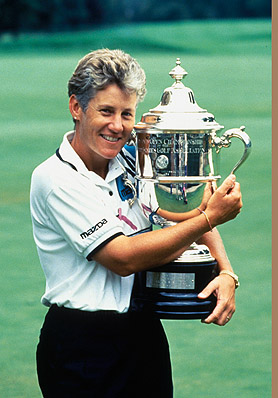Oakmont, USGA To Team Up Again
 |
The last time the USGA visited Oakmont was in 2007 when Angel Cabrera walked away with the U.S. Open crown. (John Mummert/USGA) |
By Gerry Dulac
The marriage began more than 90 years ago, a union that has linked a golf club with such iconic champions as Bob Jones, Ben Hogan and Jack Nicklaus and with modern-day conquerors Larry Nelson, Ernie Els and Angel Cabrera. Over that time, no club in America has been as intrinsically associated with national championships as Oakmont (Pa.) Country Club, that fiendish, wondrous beast with a membership littered with single-digit handicaps and a historical timeline that encompasses golf’s greatest players.
When S. Davidson Herron beat the legendary Jones in the 1919 U.S. Amateur final, the moment signified the beginning of a tantalizing romance between Oakmont and the United States Golf Association, a relationship that has seen the club host 14 USGA championships, including a record eight U.S. Opens.
That number is set to grow by two when the 2010 U.S. Women’s Open is conducted this July following an 18-year absence, and the U.S. Open returns in 2016, just nine years after the long-hitting Argentinean Cabrera held off Tiger Woods and Jim Furyk – marking the shortest time between U.S. Opens for Oakmont since Hogan’s triumph in 1953 and Nicklaus’ playoff victory over Arnold Palmer in 1962.
This marriage between Oakmont and the USGA fits like Bogie and Bacall.
“I think the USGA has great respect for the club and the tradition we have at Oakmont,” said club president Bill Griffin. “Oakmont is one of the premier … clubs in the country in relation to hosting major championships. I think the USGA views us that way and the course is ideally suited to major championships.”
Just three years after the successful 2007 U.S. Open, Oakmont will host the U.S. Women’s Open for only the second time, on July 5-11. The first was in 1992, and it is remembered around western Pennsylvania for several reasons, not the least of which is that both of Pittsburgh’s major metropolitan newspapers – The Press and Post-Gazette – were in the midst of a strike that would last seven months. Local coverage was limited to suburban newspapers and television reports.
Patty Sheehan, who had never won a Women’s Open, finally broke through by beating her good friend and ex-San Jose State roommate, Juli Inkster, in an 18-hole Monday playoff, 72-74. After a thunderstorm halted play during the final round, Sheehan came back from the weather delay to birdie the final two holes and force the playoff.
 |
Patty Sheehan avenged a previous U.S. Women's Open showing, winning the championship in 1992 at Oakmont. (USGA Museum) |
“It’s a great golf course,” Inkster said a couple of months ago. “I’m looking forward to it. I heard they took some trees down. I watched a little bit of the [2007 U.S. Open], it didn’t look that different. Most of the greens, I remember, slope from front to back. I’m sure it will play a lot different. I just remember you had to golf your ball, put it in spots and go from there.”
Five U.S. Amateur Championships have also been contested at Oakmont, the most recent in 2003 when Nick Flanagan, a 19-year-old Australian, bested American star Casey Wittenberg with a par on the 37th hole. Flanagan did it with a variety of amazing up-and-downs, something not typically done around Oakmont’s wickedly fast greens, and became the first Australian since Walter Travis in 1903 (ironically, the year Oakmont was founded) to win the U.S. Amateur.
“It’s a big part of the culture at the club,” Griffin said of hosting USGA championships.
Curiously, it was shortly after the U.S. Women’s Open in 1992 that Oakmont began an extensive – some would say contentious – course restoration that included the removal of between 5,000 and 8,000 trees, a number that is wide-ranging because some were being removed without the knowledge of the membership.
The program, which lasted nearly 14 years, was designed to return the brutish layout to the original appearance desired by founder Henry C. Fownes, a Pittsburgh industrialist who built Oakmont on barren farmland near the Allegheny River because the property reminded him of the windswept landscape of Scotland.
Nonetheless, the renovation received rave reviews before and after the 2007 U.S. Open, and has helped restore some luster to the Oakmont tradition.
The USGA was so pleased with the new look it began advising other clubs seeking to undergo similar restoration to visit Oakmont.
“It’s really about the heritage of the Fownes family,” said Bob Ford, Oakmont’s head professional since 1975. “He built the golf course to host major championships. We’ve just maintained that history every decade. And the members embrace it, they really do.”
Gerry Dulac covers golf for the Pittsburgh Post-Gazette.
